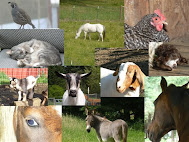In taking a closer look at paring down my weekly grocery bill, I decided that perhaps having one dinner per week based on beans might be prudent. I grabbed a couple bags of dried beans off the grocery shelves and started researching a few recipes. Now I routinely purchase canned beans all the time, but I was also interested in cooking my own beans to see how much extra work it would involve, if there was a taste difference, and to see if there would be a cost savings. And to top it all off, I know that including more beans in one's diet is a healthy way to go.
There are many tasty recipes out there. At the end of this post is the recipe for Tuscan White Beans recently published in the FoodDay section of our local newspaper, The Oregonian. The recipe was easy and tasted fantastic. A definite keeper.
How about cost savings on purchasing dried beans? Safeway.com prices their store brand of dried bean varieties at about .09 to .10 per ounce. Similar types of beans of their store brand canned variety price out at .06 to .07 per ounce. But that cannot be taken as a true comparison as the canned beans have already been cooked. Dry beans will triple their volume once cooked, so a more accurate comparison could be made by using .03 to .04 per ounce per final cooked weight of the dried beans. That's basically half the cost of the canned variety.
Everyone has heard about the health benefits of beans, but what specifically are they? Fiber is one of the number one benefits. They contain both insoluble and soluble fiber which contribute towards a healthy digestive tract by moving along digested food and absorbing fats, cholesterol and carbohydrates. In other words, a healthy gut equals lower risk of cancer and lower cholesterol levels.
Beans are a great source of non-fat protein. There are 16 grams of protein in just one cup. That's impressive.
Another benefit of beans is that they are a complex carbohydrate. These are the carbs that are considered to have a low or moderate glycemic index which help provide energy over a longer period of time by being slowly released into your bloodstream as opposed to a sudden rush of carbs.
And the USDA recommends that adults eat more than three cups of beans each week for maximum health benefits. That's three times more than the current average American currently eats. I'm all for upping those figures in our family.
By now you're also thinking that beans are healthy, and oh yes, the magical fruit. You know ... the more you eat the more you ... Well, here's some surprising news. Research shows that cooking your own beans and following the soaking/rinsing practice will greatly reduce the occurrence of intestinal gas. Cooking the beans slowly will also lessen any undesirable after affects of eating beans.
By following these simple soaking methods - I prefer the overnight method - cooking your own beans becomes easy and lessens worries you might have about eating them.
Soaking Dry-Packaged Beans
Before cooking, soak dry-packaged beans to help soften and return moisture to the beans and reduce cooking time. Most beans will rehydrate to triple their dry size, so be sure to start with a large enough pot.
•Preferred Hot Soak and Quick Soak Methods — Hot soaking helps dissolve some of the gas-causing substances, making the beans easier to digest. For each pound beans, add 10 cups hot water; heat to boiling and let boil 2 to 3 minutes. Remove from heat, cover and set aside for at least one hour (Quick Soak), or up to 4 hours (Hot Soak).
•Traditional Overnight Soak — For each pound (2 cups) dry-packaged beans, add 10 cups cold water and let soak overnight, or at least 8 hours.
This info alone was enough for me to decide that beans are cheap but extremely healthy eats. Here are some tidbits that will help you convert your existing canned bean recipes to one using dried beans.
15 oz can beans = 1-1/2 cups cooked beans, drained
16 oz or 1 pound dry beans = 2 cups dry beans = 6 cups cooked beans
8 oz or 1/2 lb dry beans = 1 cup dry beans = 3 cups cooked beans
4 oz or 1/4 lb dry beans = 1/2 cup dry beans = 1-1/2 cups cooked beans
Here's also a helpful calorie/fiber conversion:
2 oz or 1/8 lb dry beans = 1/4 cup dry beans = 3/4 cup cooked beans = 90 to 100 calories = 5-9g fiber
Not sure what variety of bean to start experimenting with? Here's a list of the beans I'm more familiar with and have the most experience cooking with:
Black
Medium-sized, black-skinned ovals
Also called Turtle bean
A favorite in South and Central American and Caribbean cuisine
Cooking Time: 1 to 1-1/2 hours
Dark Red Kidney
Large, deep reddish-brown and kidney-shaped
Famous in Red Beans and Rice
Popular in chili, soups and salads
Cooking Time: 1-1/2 to 2 hours
Light Red Kidney
Large, light red and kidney-shaped
Famous in Red Beans and Rice
Popular in chili, soups and salads
Cooking Time: 1-1/2 to 2 hours
Navy
Small white ovals
Belongs to the White bean or Haricot bean family
Often used in baked beans, soups and salads
Cooking Time: 1-1/2 to 2 hours
Great Northern
Medium-sized, white oval
Belongs with the White bean or Haricot bean family
Often used in soups, stews and Cassoulet
Cooking Time: 45 to 60 minutes
Pinto
Medium-sized, mottled beige and brown ovals
When cooked, loses mottling and turns brown
Staple in Latino cooking
Often found, whole or refried, in favorites like burritos and tacos
Cooking Time: 1-1/2 to 2 hours
Most, but not all recipes, will include instructions for soaking and cooking dried beans. But if you're substituting your own dried beans for the canned variety, here are basic directions for cooking your own beans.
Cooking Dry-Packaged Beans
•Drain soaking water and rinse beans; cook in fresh water. In general, beans take 30 minutes to 2 hours to cook depending on variety. Check bean packaging for specific cooking times and instructions.
•Spice up beans while they cook. Seasonings such as garlic, onion, oregano, parsley or thyme can be added to the pot while beans are cooking. Add acidic ingredients, such as tomatoes, vinegar, or citrus juices, only at end of cooking, when the beans are tender.
•Add salt only after beans are cooked to tender. If added before, salt may cause bean skins to become impermeable, halting the tenderizing process.
•To test for doneness, bite-taste a few beans. They should be tender, but not overcooked. When cooling, keep beans in cooking liquid to prevent them from drying out.
Okay, and now for the promised recipe:
Tuscan White Beans
2 to 3 ounces bacon, minced
2 tablespoons olive oil
1 medium red onion, diced fine
1 large carrot, diced fine
1 stalk celery, diced fine
pinch crushed red pepper flakes
pinch fennel seeds (these really give the beans their fantastic taste!)
salt
1 pound Great Northern beans, sorted and soaked in water overnight
1 head garlic, top 1/8 cut off to expose cloves
1 bay leaf
6 cups chicken broth and/or water
Combine bacon and oil in a large Dutch oven or stockpot set over medium-high heat and cook until bacon has rendered its fat, 3 to 5 minutes. Add onion, carrot, celery, red pepper flakes, fennel seeds and large pinch of salt and cook, stirring occasionally, until beginning to brown and sticking to bottom of pot, 12 to 15 minutes. Stir in beans, garlic head, bay leaf, and broth and/or water; bring to boil, then reduce heat to low and simmer, partially covered, until beans are soft and tender (adding additional liquid as necessary to cover), 1-1/2 to 2 hours.
Remove garlic and bay leaf from pot. Discard bay leaf. When cool enough to handle, squeeze garlic cloves from paper skins, mash to paste with back of knife, and stir into beans. Adjust seasoning to taste with salt and a pinch of sugar, if needed.
Serve with a sprinkling of grated parmesan cheese or garlicy bread sticks and a large green salad. Mmm good.
Do you love or hate beans? Have you tried cooking them from scratch? I'd love to hear your experiences and what you have learned.
If you're interested in doing some more research on your own, here are some sites I found helpful:
http://www.treehugger.com/files/2009/01/beans-without-flatulence.php
http://www.recipenet.org/health/articles/beans_chart.htm
http://www.johnrussell.name/recipes/beans.htm
http://americanbean.org/
Tuesday, March 31, 2009
When Frugal Minded Meets the Kitchen: Cooking with Dried Beans
Labels: cooking, frugal living
Subscribe to:
Post Comments (Atom)


.jpg)







.JPG)





+(2).jpg)



2 comments - click here to leave your comments:
We have beans at least twice a week. You can also cook dried beans in the crock pot. I have the exact recipes somewhere, but you don't really need it. Just throw them in with lots of water and cook on high until they are done (4-6 hours). Also, you can freeze cooked beans and then they are as convenient as canned.
Thanks for the posst
Post a Comment
I'd love to hear what you think, so leave me a message. Have a great day!